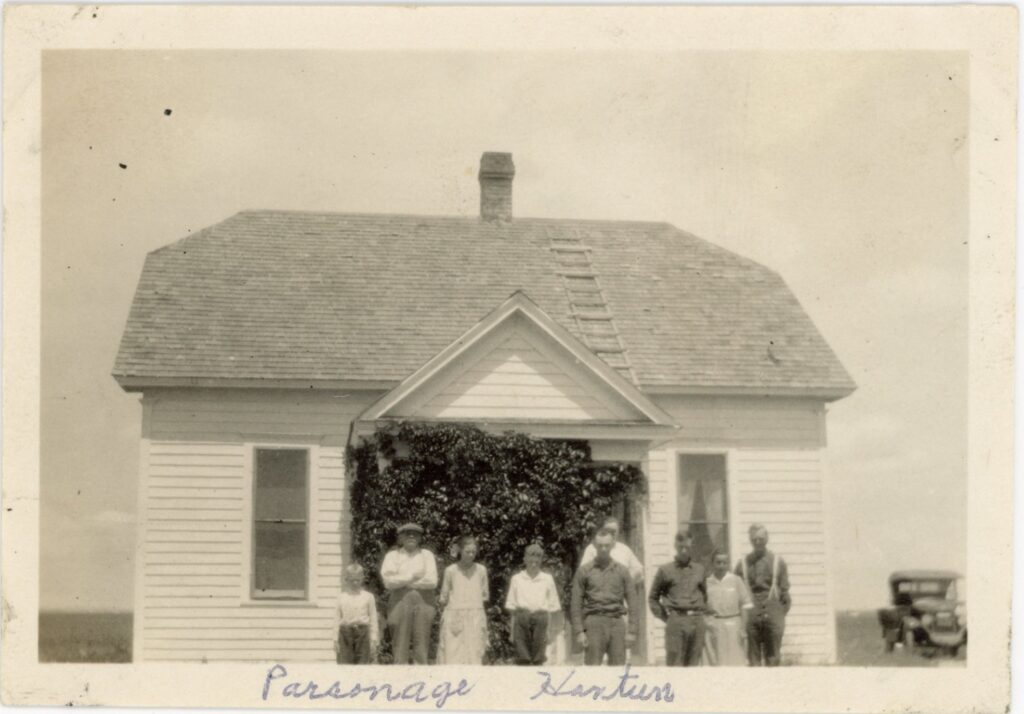About 120 miles west of McCook, by way of Highway 6, lies the small town of Haxtun, Colorado. It’s out on the lonely high plains with endless fields of dryland wheat, some farmed to this day by descendants of Swedish homesteader settlers.
About five miles north of Haxtun, and maybe seven miles back to the east lies the former farming community of Fairfield, no longer on the map. Still remaining, however, is the Fairfield Covenant Church and cemetery. A quick browse through the 1920 census shows dozens of Phillips County residents who were born in Nebraska to Swedish immigrants. No doubt one or two had connections to Saunders County.
So as the family planned their trip to Colorado, it would have made sense to take a sidetrack to Fairfield and who knows, maybe get a chance for a bath and a warm meal, perhaps bröd and kaffe. Clarinda took two pictures there – one of the church, and then a group photo in front of the parsonage.
At right are Lawrence, Wallace, Hulda and Ed. The people to the left are likely the pastor and his family (according to a published history of the church1, the pastor at the time was C.W. Bengston). The Model T is visible in the background.
Perhaps they made better time from Fairfield to Denver than they had on the first leg of their trip. Certainly mud isn’t the problem in Colorado that it would be in Nebraska.
Upon arriving in Denver, the family was able to camp in style! Clarinda labeled a photo, “Overland Park” and that leads to an interesting discovery. Overland Park was located near downtown Denver near West Jewell Avenue and South Delaware Street – right across the South Platte River from Ruby Hill Park. Today, it is the Overland Golf Course. But back in the day, wow, was it something!
It was a trend-setting “auto camp” and probably the finest in the nation, the “Manhattan of auto-camps”. In business from about 1917 until 1930, it had a 400-seat movie theater, tourist information services, evening lectures, restaurant, barber shop, gas station, automotive repair garage, grocery store and laundry accommodations. It was laid out in a grid of 800 individual lots that could accommodate up to 6,000 autocampers. See below for a gallery of photos obtained from the Denver Public Library’s Special Collections.
I don’t often use “trend-setting” as a phrase applied to to Hansons and Rudeens of this era but they were really doing something cutting-edge on this trip! Amazing! Here’s a photo that Clarinda took:
The next photo is equally amazing. I should tell you that the originals of these photos are pretty small, just 2″ x 3″ and it’s almost impossible to see faces (at least with my 60-year-old eyes). It wasn’t until I scanned and enlarged this photo that I could see some guests they entertained while camped at Overland Park. Can you recognize them?
I could tell that the couple in the center was Fred and Ida Mostrom (Ida was Hulda’s sister). I wasn’t sure about the little boy and the other couple. But no fear, the guests proudly reported their travel plans to the Ashland Gazette2 before they left:
I believe Mrs. Hugo Carlson is Ellen (Martinson), an older sister to both Ida and Hulda. What adventurous girls!
There were other Saunders County travelers to Denver that summer. In the same issue of the Ashland Gazette, I found this:
Overland Park was an early prototype for today’s KOA Campgrounds and other camping resorts. For more information, here are some fun articles:
Camping in the Heart of Denver
How America Joined its Two Great Loves, Cars and the Outdoors
Overland Park Photo Gallery (photos from Denver Public Library’s Special Collections)
Continue to Part 3 in the series
175th Anniversary, Fairfield Covenant Church, Haxtun, Colorado







Thank you!!!!
Very cool! I lived in Denver for 37 years or so…(with Larry Eldorado as a good friend..) Never new this much about Overland Park. Thanks!